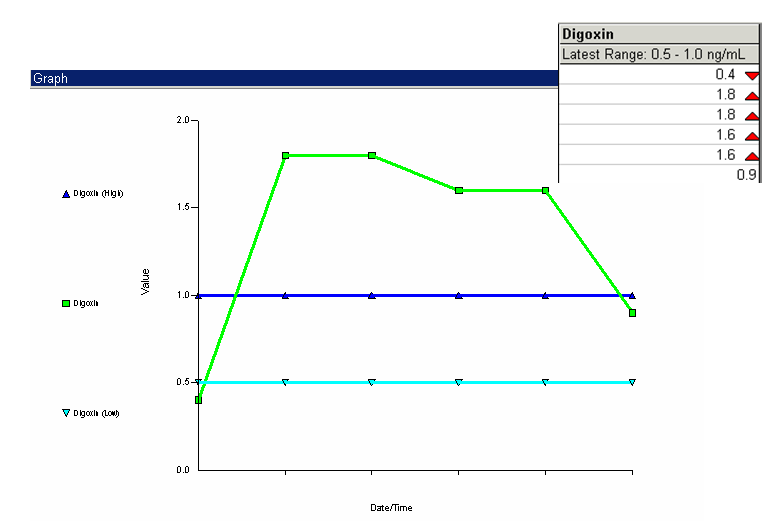- FORUM
- KRONOFORUM
- III- GEREKLiLiKLER
- USMLE Sınavları
- USMLE Step 2 CK (Clinical Knowledge)
- Elderly female with CHF complains of abdominal pain, nausea and vomiting, dizziness, and confusion for 5 days. What is the cause?
 Elderly female with CHF complains of abdominal pain, nausea and vomiting, dizziness, and confusion for 5 days. What is the cause?
Elderly female with CHF complains of abdominal pain, nausea and vomiting, dizziness, and confusion for 5 days. What is the cause?
14 years 1 month ago #1
by umc
Elderly female with CHF complains of abdominal pain, nausea and vomiting, dizziness, and confusion for 5 days. What is the cause? was created by umc
Author: V. Dimov, M.D.
Reviewer: S. Randhawa, M.D.
Cleveland Clinic Department of Medicine
A 96-year-old African American female (AAF) was admitted from a nursing home with complaints of abdominal pain, nausea and vomiting (N/V), dizziness, confusion and double vision for 5 days. She was discharged from the hospital just 4 days ago. Digoxin was started during that previous hospitalization for control of tachycardia in atrial fibrillation. One day prior to discharge, digoxin level was 1.8 mg/mL and digoxin dose was decreased to 125 mcg PO Q 48 hr.
Past medical history (PMH)
Hypertension, atrial fibrillation, coronary artery disease, stroke, congestive heart failure.
Medications
Metoprolol, digoxin, ASA (aspirin), lisinopril, furosemide (Lasix), Coumadin (warfarin), esomeprazole (Nexium).
Physical examination
In pain, combative and confused.
VSS.
Chest: Occasional bibasilar crackles.
Cardiovascular System: Clear S1 and S2, irregularly irregular rhythm, HR 101 bpm.
Abdomen: Soft, epigastric tenderness, no rebound, + BS.
Extremities: No edema.
What is the most likely diagnosis?
What would you do?
What is the most likely diagnosis?
Digoxin toxicity.
Laboratory results
Figure 1. Digoxin toxicity. Treatment with digoxin was started in the hospital and the patient was discharged to SNF, she was re-admitted 4 days later with digoxin toxicity.
What would you do?
Stop digoxin.
Monitor digoxin levels.
Control symptoms.
Sitter in the room.
What happened?
The initial digoxin level was elevated at nearly twice the upper therapeutic level. All symptoms resolved as digoxin level decreased to therapeutic range. Heart rate was controlled by increasing metoprolol dose.
She was discharged back to the nursing home in good condition.
Final diagnosis
Digoxin toxicity.
Summary
Digoxin toxicity was first described in 1785.
Approximately 0.4% of all hospital admissions, 1.1% of outpatients on digoxin, and 10-18% of nursing home patients develop toxicity. Advanced age ( older than 80 years) is an independent risk factor associated with increased morbidity and mortality.
Serum concentrations associated with toxicity overlap between therapeutic and toxic ranges because of the many factors which can potentiate digoxin toxicity.
References
Digitalis Toxicity. eMedicine, 2006.
Toxicity, Digitalis. eMedicine, 2006.
Digoxin from Oxford handbook of clinical medicine By Murray Longmore, Ian Boden Wilkinson, Supraj R. Rajagopalan:
Reviewer: S. Randhawa, M.D.
Cleveland Clinic Department of Medicine
A 96-year-old African American female (AAF) was admitted from a nursing home with complaints of abdominal pain, nausea and vomiting (N/V), dizziness, confusion and double vision for 5 days. She was discharged from the hospital just 4 days ago. Digoxin was started during that previous hospitalization for control of tachycardia in atrial fibrillation. One day prior to discharge, digoxin level was 1.8 mg/mL and digoxin dose was decreased to 125 mcg PO Q 48 hr.
Past medical history (PMH)
Hypertension, atrial fibrillation, coronary artery disease, stroke, congestive heart failure.
Medications
Metoprolol, digoxin, ASA (aspirin), lisinopril, furosemide (Lasix), Coumadin (warfarin), esomeprazole (Nexium).
Physical examination
In pain, combative and confused.
VSS.
Chest: Occasional bibasilar crackles.
Cardiovascular System: Clear S1 and S2, irregularly irregular rhythm, HR 101 bpm.
Abdomen: Soft, epigastric tenderness, no rebound, + BS.
Extremities: No edema.
What is the most likely diagnosis?
What would you do?
What is the most likely diagnosis?
Digoxin toxicity.
Laboratory results
Figure 1. Digoxin toxicity. Treatment with digoxin was started in the hospital and the patient was discharged to SNF, she was re-admitted 4 days later with digoxin toxicity.
What would you do?
Stop digoxin.
Monitor digoxin levels.
Control symptoms.
Sitter in the room.
What happened?
The initial digoxin level was elevated at nearly twice the upper therapeutic level. All symptoms resolved as digoxin level decreased to therapeutic range. Heart rate was controlled by increasing metoprolol dose.
She was discharged back to the nursing home in good condition.
Final diagnosis
Digoxin toxicity.
Summary
Digoxin toxicity was first described in 1785.
Approximately 0.4% of all hospital admissions, 1.1% of outpatients on digoxin, and 10-18% of nursing home patients develop toxicity. Advanced age ( older than 80 years) is an independent risk factor associated with increased morbidity and mortality.
Serum concentrations associated with toxicity overlap between therapeutic and toxic ranges because of the many factors which can potentiate digoxin toxicity.
References
Digitalis Toxicity. eMedicine, 2006.
Toxicity, Digitalis. eMedicine, 2006.
Digoxin from Oxford handbook of clinical medicine By Murray Longmore, Ian Boden Wilkinson, Supraj R. Rajagopalan:
Please Log in or Create an account to join the conversation.
- FORUM
- KRONOFORUM
- III- GEREKLiLiKLER
- USMLE Sınavları
- USMLE Step 2 CK (Clinical Knowledge)
- Elderly female with CHF complains of abdominal pain, nausea and vomiting, dizziness, and confusion for 5 days. What is the cause?
Time to create page: 0.088 seconds


